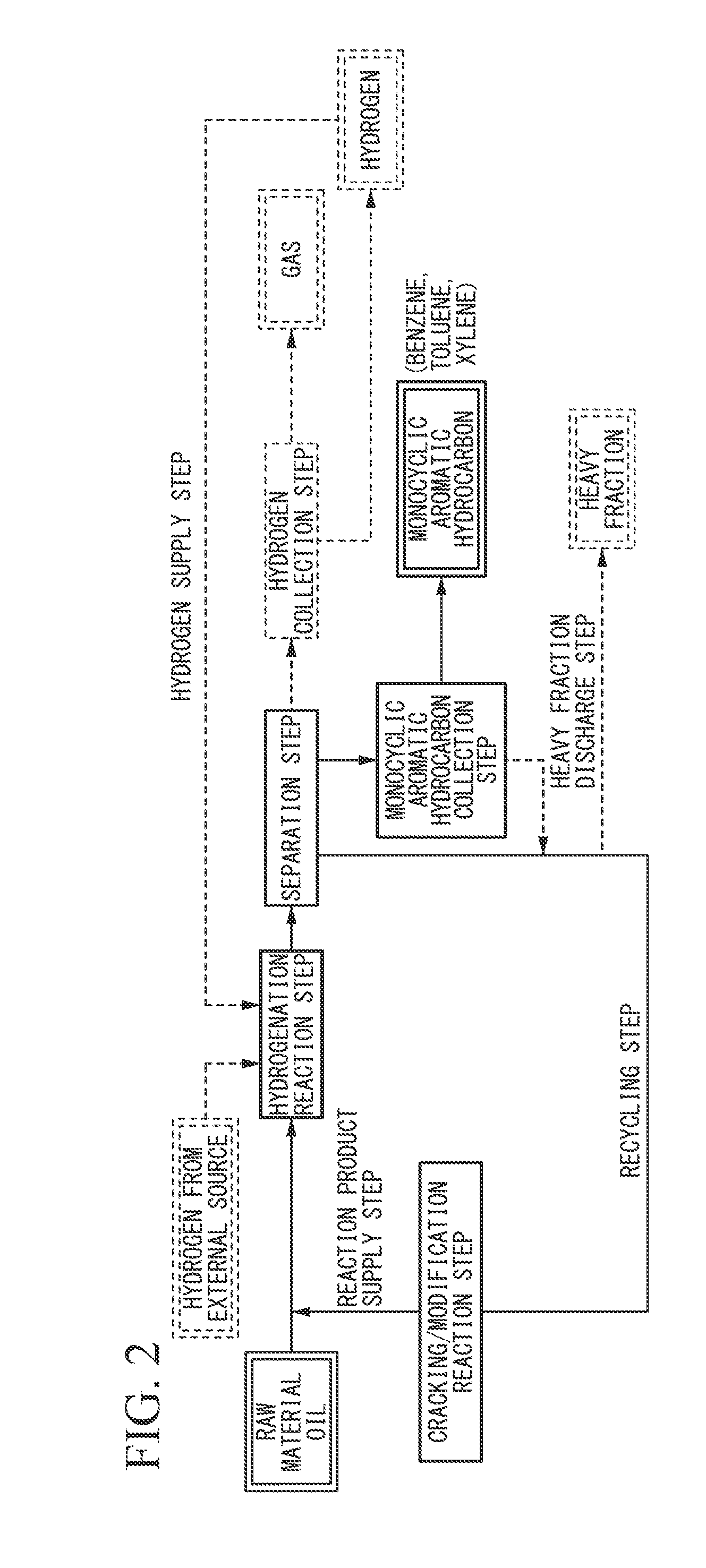Method for producing monocyclic aromatic hydrocarbons
- Summary
- Abstract
- Description
- Claims
- Application Information
AI Technical Summary
Benefits of technology
Problems solved by technology
Method used
Image
Examples
embodiment 1
[0022]Hereinafter, Embodiment 1 of the method for producing monocyclic aromatic hydrocarbons of the invention will be described.
[0023]FIG. 1 is a diagram for illustrating Embodiment 1 of the method for producing monocyclic aromatic hydrocarbons of the invention. The method for producing monocyclic aromatic hydrocarbons of the present Embodiment is a method of producing monocyclic aromatic hydrocarbons having 6 to 8 carbon atoms from an oil feedstock.
[0024]That is, the method for producing monocyclic aromatic hydrocarbons of the present Embodiment, as illustrated in FIG. 1, preferably includes:
[0025](a) a cracking reforming reaction step of bringing an oil feedstock into contact with a catalyst for monocyclic aromatic hydrocarbon production, and causing the oil feedstock to react, thereby obtaining a product containing monocyclic aromatic hydrocarbons having 6 to 8 carbon atoms;
[0026](b) a hydrogenation reaction step of hydrogenating the product produced in the cracking reforming rea...
modified example of embodiment 1
[0137]In Embodiment 1, the entire amount of the oil feedstock is supplied to the cracking reforming reaction step; however, as illustrated in FIG. 1, a portion of the oil feedstock may be directly supplied to the hydrogenation reaction step.
[0138]That is, an oil feedstock mixing step in which a portion of the oil feedstock is mixed with the product produced in the cracking reforming reaction step may be provided.
[0139]The concentration of the polycyclic aromatic hydrocarbons in the mixed oil which will be treated in the subsequent hydrogenation reaction step can be decreased compared with the case of Embodiment 1 where the entire amount of the oil feedstock is supplied to the cracking reforming reaction step by mixing a portion of the oil feedstock with the product produced in the cracking reforming reaction step so as to produce a mixed oil in the raw material mixing step. That is, in the cracking reforming reaction step, since bicyclic aromatic hydrocarbons (polycyclic aromatic hy...
embodiment 2
[0141]Embodiment 2 of the method for producing monocyclic aromatic hydrocarbons of the invention will be described.
[0142]FIG. 2 is a diagram for illustrating Embodiment 2 of the method for producing monocyclic aromatic hydrocarbons of the invention, and the method for producing monocyclic aromatic hydrocarbons of the present Embodiment is also a method for producing monocyclic aromatic hydrocarbons having 6 to 8 carbon atoms from an oil feedstock.
[0143]That is, the method for producing monocyclic aromatic hydrocarbons of the present Embodiment includes, as illustrated in FIG. 2:
[0144](i) a hydrogenation reaction step of hydrogenating an oil feedstock;
[0145](j) a separation step of separating a hydrogenation product obtained in the hydrogenation reaction step into plural fractions;
[0146](k) a monocyclic aromatic hydrocarbon recovery step of recovering monocyclic aromatic hydrocarbons having 6 to 8 carbon atoms separated in the separation step;
[0147](l) a heavy fraction discharge step...
PUM
| Property | Measurement | Unit |
|---|---|---|
| Temperature | aaaaa | aaaaa |
| Temperature | aaaaa | aaaaa |
Abstract
Description
Claims
Application Information
 Login to View More
Login to View More - R&D
- Intellectual Property
- Life Sciences
- Materials
- Tech Scout
- Unparalleled Data Quality
- Higher Quality Content
- 60% Fewer Hallucinations
Browse by: Latest US Patents, China's latest patents, Technical Efficacy Thesaurus, Application Domain, Technology Topic, Popular Technical Reports.
© 2025 PatSnap. All rights reserved.Legal|Privacy policy|Modern Slavery Act Transparency Statement|Sitemap|About US| Contact US: help@patsnap.com


